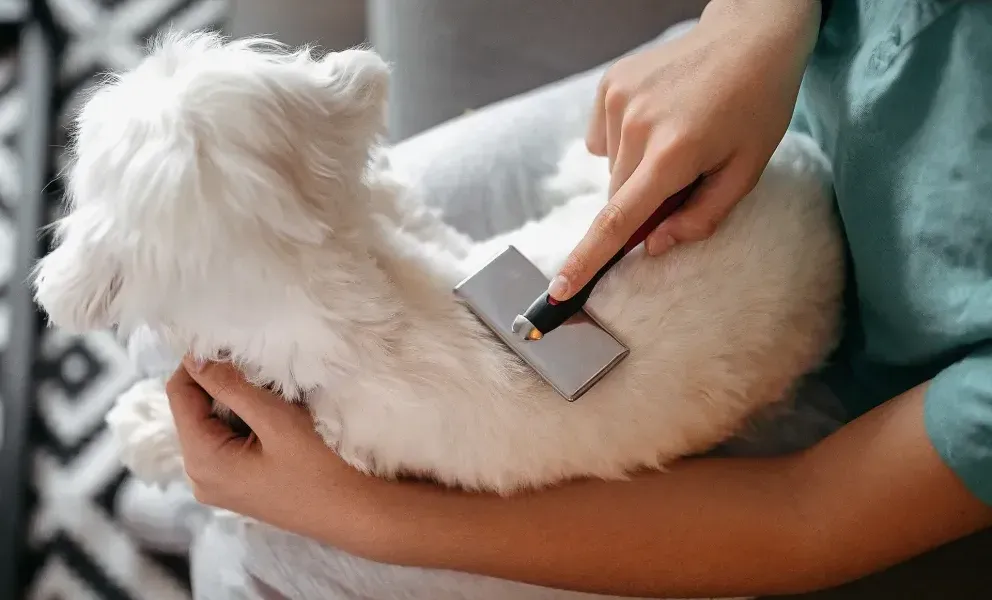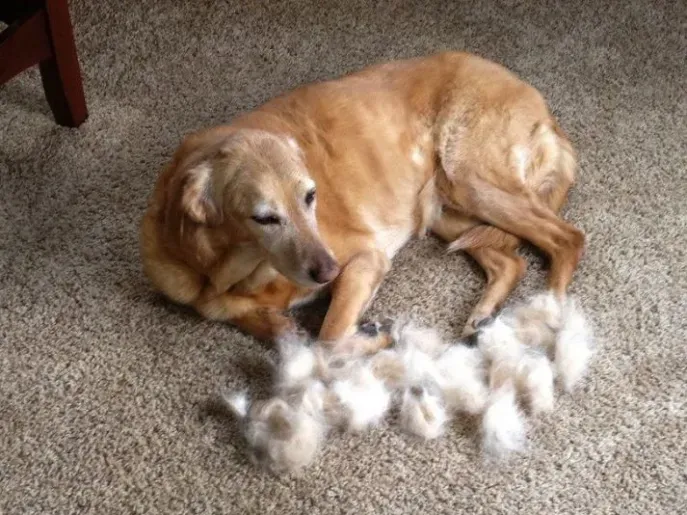Dog shedding is a common and natural process in which a dog's fur is shed, making way for new growth. While shedding is a normal part of a dog's life, excessive shedding can be a concern for dog owners. Understanding why dogs shed and the factors that affect shedding can help in finding effective Dog shedding solutions and managing the issue.
Several factors contribute to dog shedding, including breed, genetics, seasonal changes, health conditions, and stress. Knowing these factors can aid in finding appropriate solutions to control shedding.
There are various tips and techniques that can help in controlling dog shedding. Regular brushing, proper nutrition, grooming techniques, frequent bathing, and managing environmental factors are some of the effective methods to minimize shedding.
In addition to these tips, there are specific solutions that can effectively reduce shedding in dogs. Utilizing de-shedding tools, providing a healthy diet, adding omega-3 fatty acids to their diet, regular vet check-ups, controlling allergens in the environment, using shedding control products, and considering medications or supplements can all be helpful in managing shedding.
While shedding is a natural process, excessive shedding can sometimes be a concern. It is important to be aware of the signs and seek veterinary attention if shedding is accompanied by other symptoms such as hair loss, skin irritation, or changes in behavior. By understanding the causes of shedding and implementing appropriate solutions, dog owners can effectively manage and reduce shedding, keeping their furry companions comfortable and healthy.

Key takeaways:
- Regular grooming and brushing are essential for controlling dog shedding. This helps to remove loose hair and prevent it from spreading around the home.
- A healthy diet is crucial for reducing excessive shedding in dogs. Providing a balanced diet with proper nutrition can improve coat health and minimize shedding.
- Adding omega-3 fatty acids to a dog's diet can significantly reduce shedding. These essential fatty acids promote healthy skin and coat, resulting in reduced shedding.
Understanding Dog Shedding
Understanding dog shedding is important for dog owners to effectively manage this natural process. Shedding is a normal aspect of a dog's life as their coat continuously grows. In order to comprehend dog shedding, it is crucial to consider factors such as breed, weather, and overall health. Some breeds, such as Siberian Huskies and Labrador Retrievers, tend to shed more than others. Additionally, weather has an impact, as dogs shed their undercoat more in warmer months. Regular grooming, a nutritious diet, and proper hygiene can aid in reducing shedding. Here's a helpful tip: Regularly brushing your dog's coat can minimize shedding and maintain their fur's health and shine.
Why Do Dogs Shed?
Dogs shed as a natural process of hair growth and replacement. Shedding, or the process by which dogs lose old hair to make room for new hair is necessary for their overall well-being. So, why do dogs shed? There are several factors at play, including breed, season, and general health. Certain breeds, such as Siberian Huskies, are known for their thick double coats, which means they shed quite heavily. Additionally, seasonal changes and hormonal fluctuations can affect the amount of shedding a dog experiences. To manage shedding effectively, regular brushing, a balanced diet rich in essential nutrients, and proper grooming techniques are essential. It is worth mentioning that excessive shedding could be a sign of an underlying health issue, in which case, consulting a veterinarian is highly recommended.
What are the Factors that Affect Dog Shedding?
Several factors can affect dog shedding, including breed, season, health, hormones, and environment.
1. Breed: Some breeds, like Siberian Huskies, have a thick double coat that sheds heavily, while breeds like Poodles have hair that continuously grows but sheds minimally.
2. Season: Dogs often have a heavier shed during seasonal changes, with increased shedding in spring and fall.
3. Health: Poor nutrition, allergies, or underlying health conditions can contribute to excessive shedding.
4. Hormones: Hormonal changes, such as those during pregnancy or after spaying/neutering, can impact shedding.
5. Environment: Temperature, humidity, and indoor environment can affect shedding.
In ancient Egypt, the Pharaoh Hound was highly regarded for its ability to shed less. They were believed to be sacred dogs and were often mummified and buried with their owners to accompany them in the afterlife. Their minimal shedding was seen as a sign of purity and cleanliness.

Tips for Controlling Dog Shedding
Tired of finding your dog's fur everywhere? We've got you covered with some awesome Dog shedding solutions. From regular brushing to proper nutrition and grooming techniques, we'll unleash the secrets to keeping your pup's shedding in check. Oh, and did you know that managing environmental factors and frequent bathing can also make a difference? Get ready to bid those furry tumbleweeds goodbye and say hello to a cleaner, fur-free home!
Regular Brushing
Regular brushing is a crucial component of managing dog shedding. By regularly engaging in the practice of brushing your dog's coat, you can effectively eliminate loose and dead hair, preventing it from scattering all over your house. This routine also facilitates the distribution of your dog's natural oils, thereby maintaining the health and shine of their coat. Regular brushing enables you to monitor their skin for any potential issues or abnormalities that may require attention. Ensure that you select the appropriate brush for your dog's coat type and brush with gentle strokes to prevent any discomfort.
Proper Nutrition
Proper nutrition is essential for controlling dog shedding and maintaining a healthy coat. When considering your dog's diet, there are several factors to keep in mind:
- High-quality food: It is important to choose a dog food that provides a balanced blend of protein, fat, and essential nutrients.
- Omega-3 fatty acids: Including foods rich in omega-3s, such as fish or flaxseed oil, can help promote a healthy coat and reduce shedding.
- Vitamins and minerals: Your dog's diet should include essential vitamins and minerals to support optimal coat health.
- Hydration: To keep their coat well-hydrated, it is important to ensure that your dog has access to fresh water at all times.
Fun Fact: Did you know that certain dog breeds, like Siberian Huskies, naturally have a double coat that tends to shed more compared to other breeds?
Grooming Techniques
- Grooming Techniques are an essential part of managing dog shedding. Here are some steps to help you keep your dog's shedding under control:
- Regular brushing: Brush your dog's coat at least once a week to remove loose hair and prevent it from shedding around your home.
- Proper nutrition: Feed your dog a balanced diet with high-quality ingredients to promote healthy skin and coat.
- Grooming tools: Use the right Grooming Techniques, such as de-shedding combs or slicker brushes, to remove excess hair.
- Frequent bathing: Regular baths can help control shedding by keeping your dog's coat clean and healthy.
- Environmental factors: Keep your home clean and vacuum regularly to minimize the amount of hair around your living space.
Pro-tip: For long-haired breeds, consider getting professional grooming services to help with maintaining their coat and reducing shedding.

Frequent Bathing
Frequent bathing is an important aspect of controlling dog shedding. Here are some tips to consider:
- Choose the right shampoo: Use a gentle, hypoallergenic shampoo designed for dogs to avoid skin irritation.
- Brush before bathing: Brushing your dog's coat before bathing can help remove loose fur and prevent excessive shedding.
- Use lukewarm water: Avoid using hot water as it can dry out your dog's skin and stimulate more shedding.
- Thoroughly rinse: Make sure to rinse off all shampoo residue to prevent skin irritation and itching.
- Dry properly: Use a towel or a low heat setting on a blow dryer to dry your dog's coat completely.
In ancient Egypt, frequent bathing was not just a hygiene practice for people but also for dogs. Canine companions were frequently bathed by their owners to maintain their cleanliness and health. It was believed that regular bathing helped prevent pests and diseases, making dogs more pleasant and safer to be around. The tradition of frequent bathing evolved over time, and today, it remains an essential part of proper dog care.
Managing Environmental Factors
Managing environmental factors is of utmost importance when it comes to controlling dog shedding. To minimize allergens, you can consider the following steps:
- Regularly vacuum and dust your home to maintain cleanliness and reduce the presence of allergens.
- Improve air quality and minimize shedding triggers by utilizing air purifiers or filters.
- To prevent excessive shedding, it is crucial to control humidity levels. In dry climates, a humidifier can be used, while in humid areas, a dehumidifier can be beneficial.
- Creating a comfortable and stress-free environment for your dog is essential as stress can contribute to increased shedding.
- Avoid exposing your dog to extreme temperatures and ensure proper hydration at all times.
By effectively managing environmental factors, you can significantly reduce dog shedding and cultivate a healthier living environment for both you and your beloved furry companion.

Effective Dog Shedding Solutions
Tired of finding dog fur everywhere? Say goodbye to the furry mess with effective dog-shedding solutions! From using de-shedding tools to providing a healthy diet and adding Omega-3 fatty acids, we've got you covered. Regular vet check-ups, controlling allergens, and using shedding control products are just a few tricks up our sleeve. And if needed, we'll even explore the option of medications or supplements. Get ready for a shed-free home and a happier pup!
Using Deshedding Tools
Using de-shedding tools can be an effective way to control dog shedding. Here are some steps to follow:
- Choose the right de-shedding tool for your dog's coat type, such as a slicker brush or de-shedding rake.
- Gently brush your dog's fur in the direction of hair growth to remove loose hairs.
- Be careful not to apply too much pressure, as you don't want to irritate your dog's skin.
- Pay extra attention to areas where shedding is more common, like the undercoat and tail.
- Regularly clean the de-shedding tool to remove the collected hair and keep it in good condition.
Fact: Using de-shedding-shedding tools can help reduce shedding by up to 90% in some cases.
Providing a Healthy Diet
Providing a healthy diet is crucial for managing dog shedding. Here are some tips for selecting the right diet for your dog:
- Choose a balanced and nutritious dog food that meets your dog's specific dietary needs for providing a healthy diet.
- Incorporate omega-3 fatty acids into your dog's diet, either through food sources like fish oil or through supplements, to provide a healthy diet.
- Ensure that your dog is getting enough protein, which is essential for healthy coat growth and maintenance, as part of a healthy diet.
- Avoid feeding your dog excessive amounts of carbohydrates, as this can contribute to shedding and is not a part of a healthy diet.
- Consult with your veterinarian to determine the best diet plan for your dog's specific needs and health conditions, ensuring a healthy diet plan.
Adding Omega-3 Fatty Acids to the Diet
Adding omega-3 fatty acids to a dog's diet can help reduce excessive shedding and promote a healthy coat.
- Benefits: Omega-3 fatty acids are essential for skin and coat health, reducing inflammation, and promoting overall wellness.
- Sources: Fish oil is a common source of omega-3 fatty acids for dogs. Other sources include flaxseed oil and algae-based supplements.
- Consultation: Before adding supplements to your dog's diet, consult with a veterinarian to determine the appropriate dosage and ensure it is safe for your dog.
- Feeding: Omega-3 fatty acids can be added to your dog's diet through commercial products or by providing fresh sources like fatty fish (salmon, mackerel) or mixing supplements with their food.
- Consistency: Consistently providing omega-3 fatty acids in your dog's diet is important to see long-term improvements in their coat health and shedding.
Regular Vet Check-ups
Regular vet check-ups are essential in managing dog shedding. During these routine visits, the vet can assess your dog's overall health and detect any underlying problems that might be contributing to excessive shedding. They can also offer guidance on the best grooming techniques and recommend any necessary dietary adjustments or supplements. By consistently scheduling regular check-ups, you can ensure that your dog's shedding remains within normal limits and promptly address any concerns before they escalate.
A Labrador Retriever owner noticed their dog shedding excessively out of season. They consulted a vet, who diagnosed a skin infection as the cause. Treatment and follow-up visits restored the dog's coat health. Regular vet check-ups are vital. Discover effective Dog shedding solutions for a healthier coat.
Controlling Allergens in the Environment
To effectively control allergens in the environment and minimize dog shedding, follow these steps for controlling allergens in the environment:
- Keep your home clean by regularly vacuuming carpets, furniture, and curtains.
- Wash pet bedding frequently in hot water to remove allergens.
- Use allergen-friendly cleaning products and avoid strong scented sprays.
- Keep your dog's living area clean by regularly wiping surfaces and vacuuming floors.
- Use an air purifier to filter out allergens from the air.
In my personal experience, I struggled with dog shedding allergens in my home until I implemented these measures for controlling allergens in the environment. Now, my family and I can enjoy a clean and allergen-free living environment, and our dog's shedding has significantly reduced.
Using Shedding Control Products
Using shedding control products can be an effective way to manage your dog's excessive shedding. Here are some options to consider:
- Shedding brushes: Use brushes specifically designed to remove loose hair and minimize shedding.
- Shedding shampoos: Look for shampoos that help reduce shedding and promote a healthy coat.
- Supplements: Some supplements, like omega-3 fatty acids, can improve your dog's skin and coat health, reducing shedding.
- Specialty wipes: Wipes infused with shedding control ingredients can help remove loose hair and keep your dog's coat clean.
- Deshedding sprays: These sprays can be applied to your dog's coat to reduce shedding and leave their fur smooth and healthy.

Considering Medications or Supplements
Exploring Medications and Supplements for Managing Dog Shedding: Discover Effective Dog Shedding Solutions.
- Consult with a veterinarian: A professional can recommend specific medications or supplements based on your dog's shedding patterns and overall health.
- Fatty acid supplements: Omega-3 fatty acids can help improve your dog's coat health and reduce shedding.
- Antihistamines: If allergies are causing excessive shedding, medications like antihistamines can provide relief.
- Hormonal supplements: In some cases, hormonal imbalances can contribute to excessive shedding. Hormone therapy or supplements may be prescribed to regulate shedding.
- Medicated shampoos: Some shampoos contain ingredients that promote healthier skin and reduce shedding.
- Probiotics: These supplements can improve gut health and potentially reduce shedding caused by dietary issues.
Considering medications or supplements can be a viable solution for controlling excessive shedding in dogs. Here are some options to consider:
- Consult with a veterinarian: A professional can recommend specific medications or supplements based on your dog's shedding patterns and overall health.
- Fatty acid supplements: Omega-3 fatty acids can help improve your dog's coat health and reduce shedding.
- Antihistamines: If allergies are causing excessive shedding, medications like antihistamines can provide relief.
- Hormonal supplements: In some cases, hormonal imbalances can contribute to excessive shedding. Hormone therapy or supplements may be prescribed to regulate shedding.
- Medicated shampoos: Some shampoos contain ingredients that promote healthier skin and reduce shedding.
- Probiotics: These supplements can improve gut health and potentially reduce shedding caused by dietary issues.
When Is Excessive Shedding a Concern?
When Is Excessive Shedding a Concern? Excessive shedding can be a concern when it goes beyond the normal shedding patterns of a dog. It may indicate underlying health issues such as allergies, hormonal imbalances, or nutritional deficiencies. Pay attention to signs like bald patches, irritated skin, or drastic changes in shedding patterns. If you notice any abnormality, it's important to consult a veterinarian. They can help determine the cause of excessive shedding and provide appropriate solutions, which may include dietary changes, supplements, or medical treatments to address the underlying condition. Regular grooming and a balanced diet can also help minimize shedding in healthy dogs.
Some Facts About Dog Shedding Solutions:
- ✅ Shedding is a natural process in dogs where old fur is replaced with new fur. (Source: Our Team)
- ✅ Regularly brushing your dog with a shedding tool designed for hair removal can help minimize shedding. (Source: Our Team)
- ✅ Frequent bathing, especially for heavy shedders, can help remove excess hair and reduce shedding. (Source: Our Team)
- ✅ Blow-drying your dog's coat after bathing and brushing while drying can effectively remove loose hair. (Source: Our Team)
- ✅ Clipping your dog's coat, particularly in warm climates, can reduce shedding. (Source: Our Team)
Frequently Asked Questions
What causes dog shedding?
Dog shedding is a natural process in which a dog's body replaces old fur with new fur. The extent and frequency of shedding can vary depending on factors such as breed, weather, diet, allergies, and season.
How can I minimize shedding in my dog?
There are several strategies you can try to minimize shedding in your dog:
- Brush your dog frequently using a grooming tool designed for shedding hair.
- Bathe your dog often, especially heavy shedders, to remove excess hair.
- Blow-dry your dog's coat after bathing to help remove loose hair.
- Clip your dog's coat, especially in warm climates, to reduce shedding.
- Consider feeding your dog a high-quality dog food and providing supplements containing Omega-3 fatty acids to promote healthy skin and reduce shedding.
How do I know if my dog's shedding is excessive?
If your dog is shedding excessively or experiencing hair loss in patches, it may indicate a health problem. It is recommended to consult a vet for diagnosis and treatment.
What can I do to keep my home free of pet hair?
To keep your home free of pet hair, you can:
- Vacuum often and use lint rollers to remove pet hair from surfaces.
- Cover furniture with washable blankets that can be easily cleaned.
- Consider changing flooring to tile or hardwood, which are easier to clean.
Are there specific breeds that shed less?
Yes, some dog breeds are known to be low shedders, such as Afghan Hounds, Poodles, Irish Water Spaniels, and Portuguese Water Dogs. However, it's important to consider grooming needs and allergies when choosing a dog, as even hypoallergenic dogs can still shed to some extent.
Can I use olive oil to reduce my dog's shedding?
Using products high in omega-3, such as olive oil or fish oil, can be effective home remedies for reducing shedding. However, it's important to consult with your vet for proper dosage and use.




